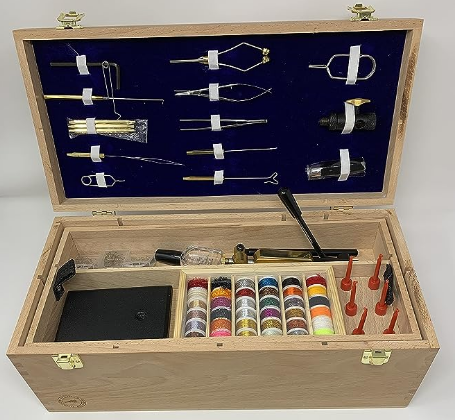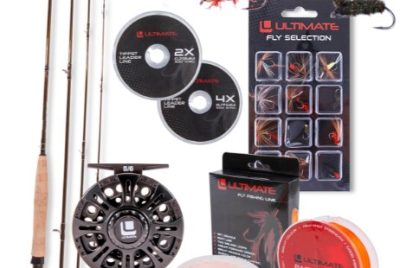Fly Fishing Starter Kit
Fly fishing is not just a hobby; it’s a passion that takes you closer to nature’s beauty and serenity. As an avid fly angler and enthusiast, I understand the excitement that comes with embarking on this incredible journey. To make your entry into the world of fly fishing as smooth and enjoyable as possible, I’m here to guide you through the essentials of a fly fishing starter kit.
Introduction to Fly Fishing
What is fly fishing?
Fly fishing is a unique form of angling that involves using an artificial fly to mimic natural prey and tempt fish to bite. It’s a method known for its elegance and precision, where the angler casts the fly line, rather than the lure or bait, to catch fish.
Why is it a popular outdoor activity?
Fly fishing is more than just catching fish; it’s about connecting with nature, challenging your skills, and finding peace in the great outdoors. It’s no wonder that it has gained a devoted following worldwide.
Getting Started with Fly Fishing
Before we dive into the importance of a fly fishing starter kit, let’s discuss the basics of getting started with this fascinating pastime.
Choosing the right fly fishing gear
To begin your journey as a fly angler, you’ll need the right gear. This includes a fly rod, reel, line, leaders, tippet, flies, and various accessories.
Understanding the basics of fly fishing techniques
Fly fishing techniques involve delicate presentations and precise casting. Learning these skills takes time and practice, but the rewards are worth it.
The Importance of a Fly Fishing Starter Kit
Now, let’s explore why a fly fishing starter kit is crucial for beginners.
Why a starter kit is essential
A starter kit simplifies the process for newcomers by bundling the necessary equipment, ensuring you have the basics to get started without confusion.
Cost-effective way to begin
Investing in a starter kit is cost-effective, as it often comes at a lower price than purchasing individual items separately. This makes it an excellent choice for those on a budget.
Components of a Fly Fishing Starter Kit
Let’s break down the components that make up a fly fishing starter kit.
Fly rod and reel
The fly rod and reel are the heart of your setup. They come in various sizes and materials, so choosing the right ones is essential.
Fly line and backing
The fly line is the connection between you and the fish, while backing provides extra line capacity and strength.
Leaders and Tippet
Leaders and tippet are essential for presenting the fly naturally and fooling wary fish.
Flies and fly box
Different types of flies are used to mimic various insects and baitfish. A fly box keeps your flies organized and secure.
Accessories and tools
Accessories such as nippers, forceps, and hemostats, along with fly floatant and strike indicators, are essential for a successful day on the water.
Selecting the Right Fly Rod and Reel
Choosing the appropriate fly rod and reel is crucial for a successful fly fishing experience.
Weight and length considerations
Fly rods and reels are classified by weight, which determines the type of fish you can target. Length also affects casting and control.
Matching the rod and reel
Ensure your fly rod and reel are compatible in terms of weight and functionality to achieve balanced performance.
Understanding Fly Lines and Backing
Fly lines and backing play a vital role in casting and landing fish.
Types of fly lines
Different types of fly lines are designed for specific fishing situations, such as floating, sinking, or intermediate lines.
Importance of backing
Backing is essential to prevent running out of line when battling large fish or allowing them to take long runs.
Leaders and Tippet Explained
Leaders and tippet are often overlooked but are crucial for successful presentations.
What are leaders and tippet?
Leaders are tapered lines that connect the fly line to the fly, while tippet is the thin, transparent line that extends the leader.
How to choose the right ones
Select leaders and tippet that match the size of your flies and the fish you’re targeting for a seamless connection.
Essential Flies for Beginners
Fly selection is a critical aspect of fly fishing, and beginners should start with a few essential patterns.
Dry flies, nymphs, and streamers
These three categories cover a wide range of aquatic insects and baitfish and can be used to imitate various prey.
Popular fly patterns for starters
Explore some popular fly patterns that have proven effective for beginners.
Must-Have Accessories and Tools
To make your fly fishing journey more enjoyable, don’t forget to pack these essential accessories and tools.
Nippers, forceps, and hemostats
These tools help you handle flies, cut lines, and remove hooks safely.
Fly floatant and strike indicators
Fly floatant keeps your dry flies afloat, while strike indicators help detect subtle strikes.
Setting Up Your Fly Fishing Rig
Let’s put your starter kit to good use by assembling your fly fishing rig.
Assembling the components
Step-by-step instructions for setting up your rod, reel, line, and leader.
Attaching the leader and fly
Learn how to tie the leader to the fly line and add your chosen fly for a successful presentation.
Basic Fly Casting Techniques
Now that your rig is ready, it’s time to learn some basic fly casting techniques.
Overhead cast
Master the classic overhead cast for accuracy and distance.
Roll cast
Perfect the roll cast, ideal for tight spots and tricky currents.
False casting
Learn how to false cast to control line and improve accuracy.
Where to Go Fly Fishing
Finding the right fishing spot is crucial for a successful outing.
Finding the right fishing spot
Consider factors like location, accessibility, and the presence of fish when choosing where to fish.
Public vs. private waters
Explore the advantages and disadvantages of fishing in public and private waters.
Caring for Your Fly Fishing Equipment
Proper maintenance ensures your gear stays in top condition for years to come.
Cleaning and maintenance tips
Simple steps to clean and maintain your fly fishing equipment.
Proper storage
Learn how to store your gear to prevent damage and prolong its lifespan.
Tips for a Successful Fly Fishing Experience
Before you hit the water, here are some valuable tips to enhance your fly fishing skills.
Reading the water
Understand how to interpret the water’s characteristics and locate feeding fish.
Observing fish behaviour
Learn to observe fish behaviour and adapt your approach accordingly.
Conclusion
In conclusion, a well-equipped fly fishing starter kit is your passport to the world of fly fishing. With the right gear and knowledge, you can embark on a journey filled with excitement, challenge, and connection with nature. So, gear up and get ready to cast your first fly.
FAQs
1. How much should I budget for a fly fishing starter kit?
- The cost of a starter kit can vary, but a good-quality beginner’s kit typically ranges from $100 to $300. It’s a worthwhile investment for those looking to start fly fishing.
2. Do I need specialized clothing for fly fishing?
- While specialized clothing is not mandatory, comfortable and weather-appropriate attire is recommended. Breathable waders and a fishing vest can enhance your comfort on the water.
3. How long does it take to become proficient at fly fishing?
- Proficiency in fly fishing varies from person to person, but with practice and dedication, you can become proficient within a few months to a year.
4. Are there any safety precautions I should take while fly fishing?
- Safety is essential. Always wear a life jacket when fishing from a boat, be cautious of slippery riverbanks, and be aware of your surroundings to avoid accidents.
5. Can I fly fish in all types of water bodies?
- Fly fishing is versatile and can be done in various water bodies, including rivers, streams, lakes, and even saltwater. Each type of water offers unique fishing opportunities.



